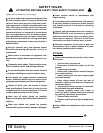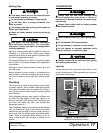
18 Operation
MAN0764 (11/5/2008)
Wing Lock-Up (Figure 3)
1. Remove safety pin and lock-up pin from storage
position.
2. Raise wing and align wing transport lock with
slotted holes in the cylinder lugs.
3. Insert lock-up pin above cylinder pin and secure
with klik pin
4. Repeat steps 1 to 3 for opposite wing.
5. Relieve hydraulic pressure from wing cylinders and
lower the wing against the wing transport lock.
Center Section Lock-Up (Figure 3)
1. Raise cutter with hydraulic cylinder to maximum
height.
2. Rotate transport lock into position over cylinder
rod.
3. Lower cutter against transport lock.
4. To lower the cutter for operation, extend hydraulic
cylinder to raise cutter. Rotate transport lock back
away from cylinder rod (Figure 4).
5. Lower the cutter to cutting height. Use cylinder
stops (stroke control kit) to set desired cutting
height.
Figure 4. Transport Lock in Operation Position
STORAGE
Follow these steps when storing your cutter:
1. Clean cutter before storing. See page 23 for
cleaning instructions. Store on level, solid ground.
2. Disconnect driveline and secure up off the ground.
3. Lower wings to ground.
4. Raise cutter center section and rotate transport
lock into position over cylinder. Relieve hydraulic
pressure.
5. Attach parking jack and raise tongue weight off
tractor drawbar.
6. Place wedge blocks at front and rear of wheels on
center section and on each wing to prevent wheel
rotation.
7. Securely block all four corners of center section
and each wing with jackstands.
8. Remove hydraulic hoses after tractor is off.
9. Remove safety tow chain.
10. Remove retainer and high strength drawbar pin.
11. Keep children and bystanders away from storage
area.
PRE-OPERATION CHECK LIST
(OWNER'S RESPONSIBILITY)
___ Review and follow all safety rules and safety
decal instructions on page 7 through page 13.
___ Check that all safety decals are installed and in
good condition. Replace if damaged.
___ Check that equipment is properly and securely
attached to tractor.
___ Make sure driveline spring-activated locking pin
or collar slides freely and is seated firmly in trac-
tor PTO spline groove.
___ Check all lubrication points and grease as
instructed in lubrication information. Make sure
the PTO slip joint is lubricated and that the gear-
box fluid levels are correct.
___ Set tractor PTO at correct rpm for your equip-
ment.
___ Check that all hydraulic hoses and fittings are in
good condition and not leaking before starting
tractor. Check that hoses are not twisted, bent
sharply, kinked, frayed, or pulled tight. Replace
any damaged hoses immediately.
___ Check that all hardware is properly installed and
secured.
___ Check cutting height and attitude adjustment.
___ Raise and lower equipment to make sure air is
purged from hydraulic cylinders and hoses.
___ Check that blades are sharp and secure and cut-
ting edge is positioned to lead with correct rota-
tion.
___ Make sure tractor ROPS or ROPS cab and seat
belt are in good condition. Keep seat belt
securely fastened during operation.
___ Check that shields and guards are properly
installed and in good condition. Replace if dam-
aged.
___ Before starting engine, operator must be in trac-
tor seat with seat belt fastened. Place transmis-
sion in neutral or park, engage brake and
disengage tractor PTO.
___ Inspect area to be cut and remove stones,
branches, or other hard objects that might be
thrown and cause injury or damage.
___ Inspect rubber or chain shielding and replace any
damaged rubber shield or missing links.
___ Make sure tractor 3-point lift links do not interfere
with hydraulic hoses or driveline throughout full
turning range.
___ Check the tire pressure for pneumatic tires. The
maximum pressure allowed is 40 psi.
DP8A
(Rev. 1/30/2009)


















